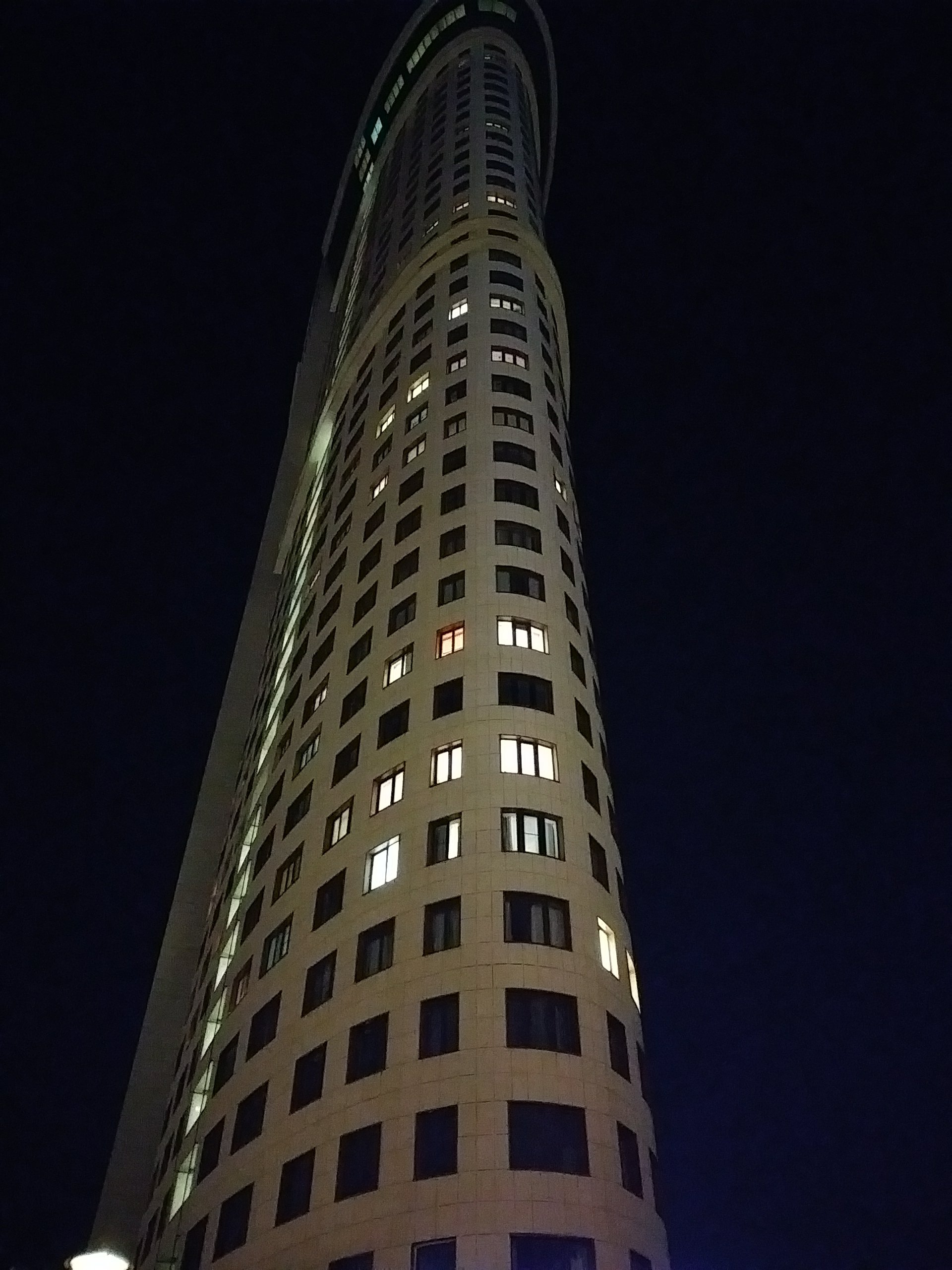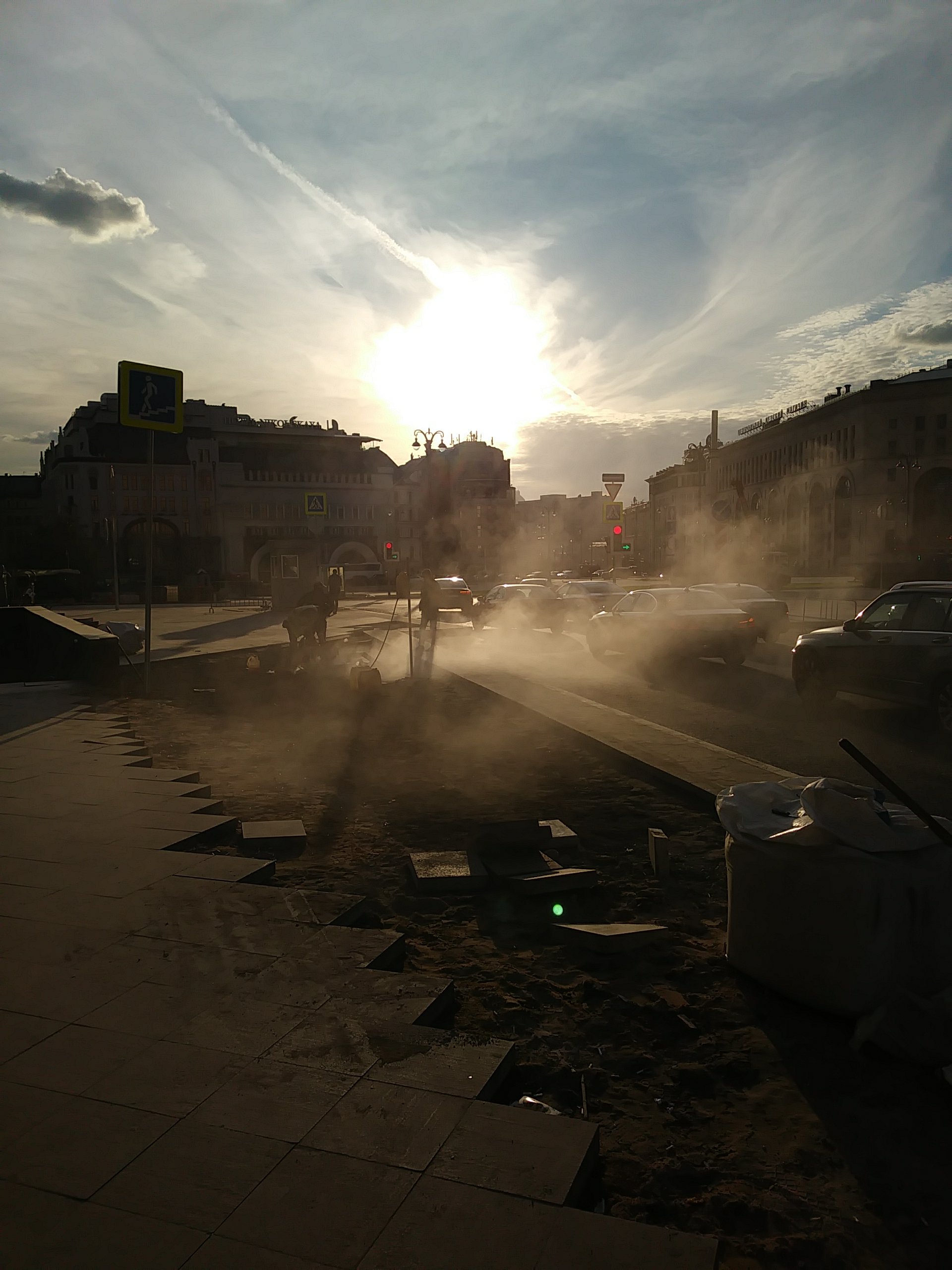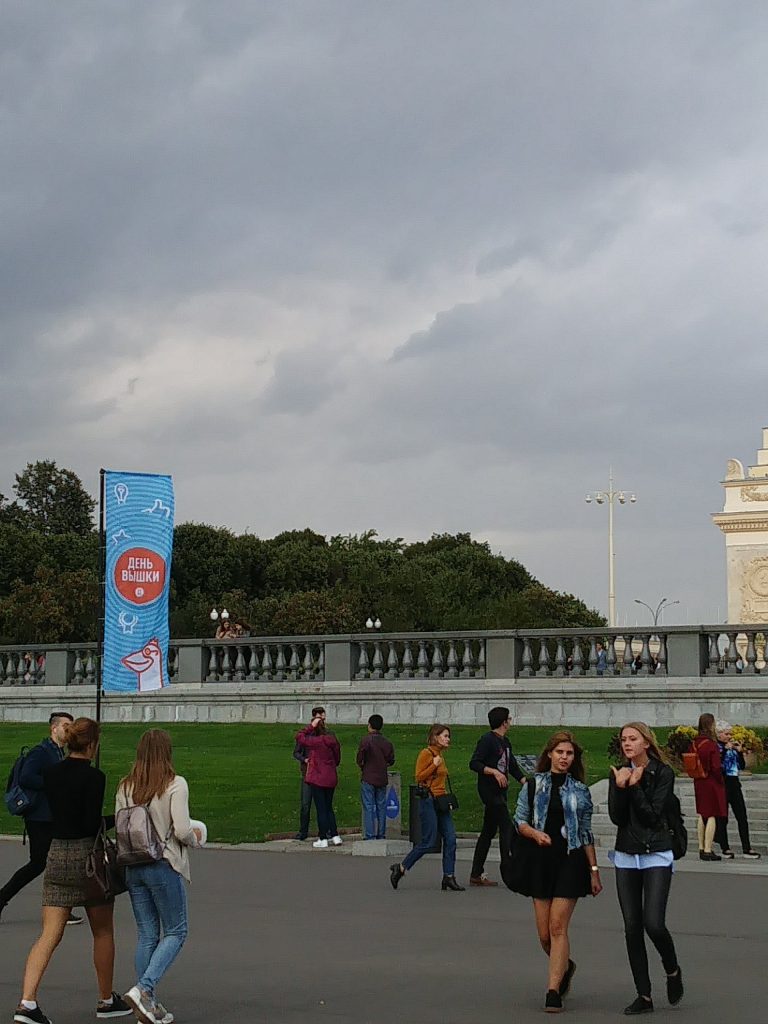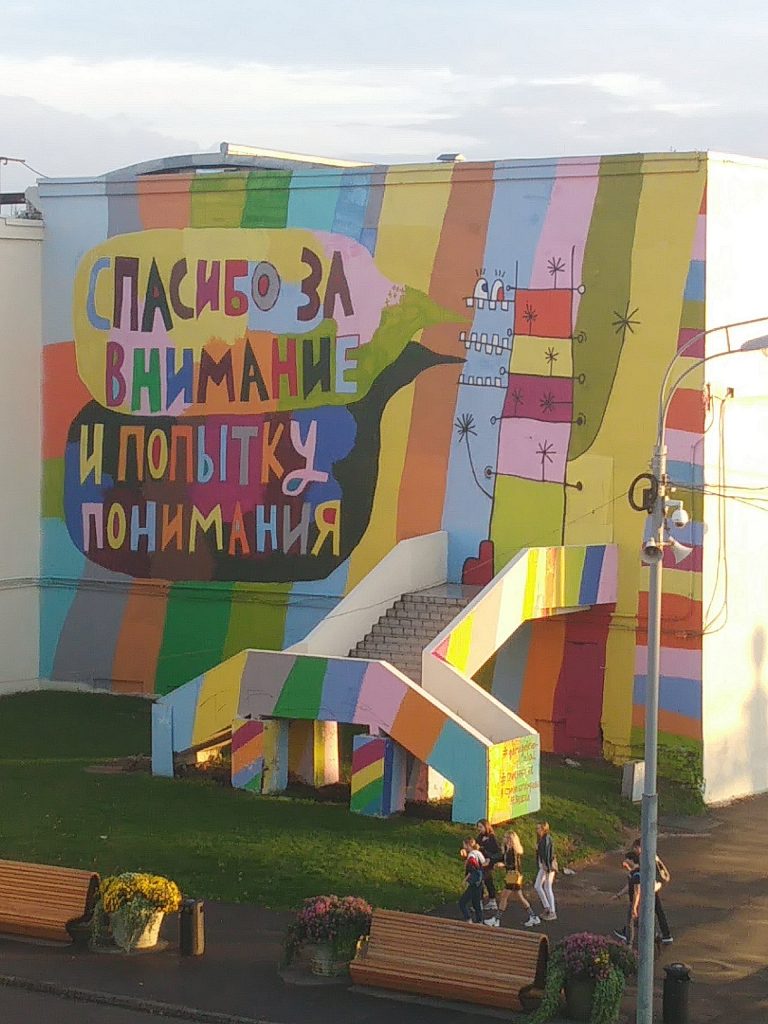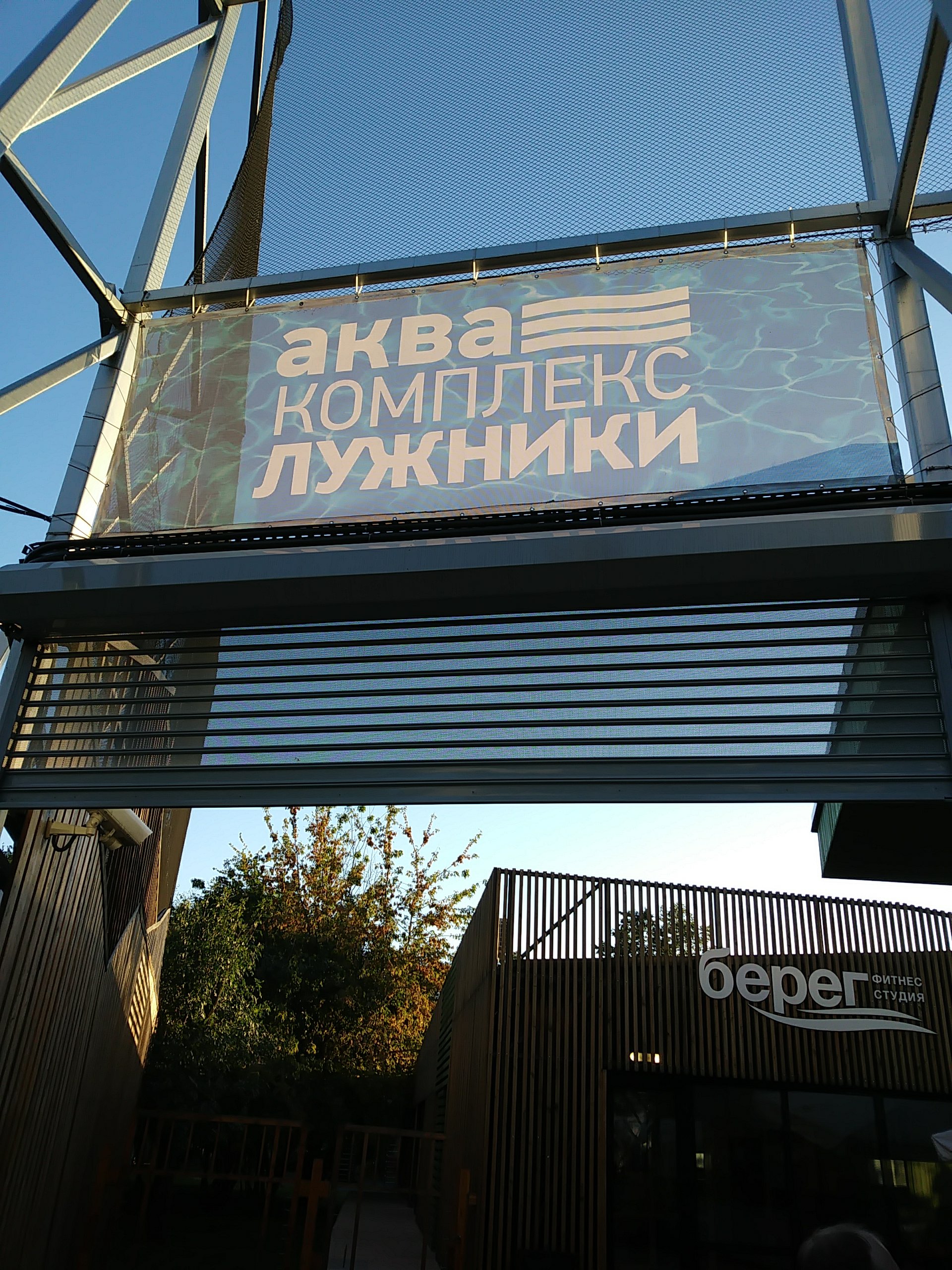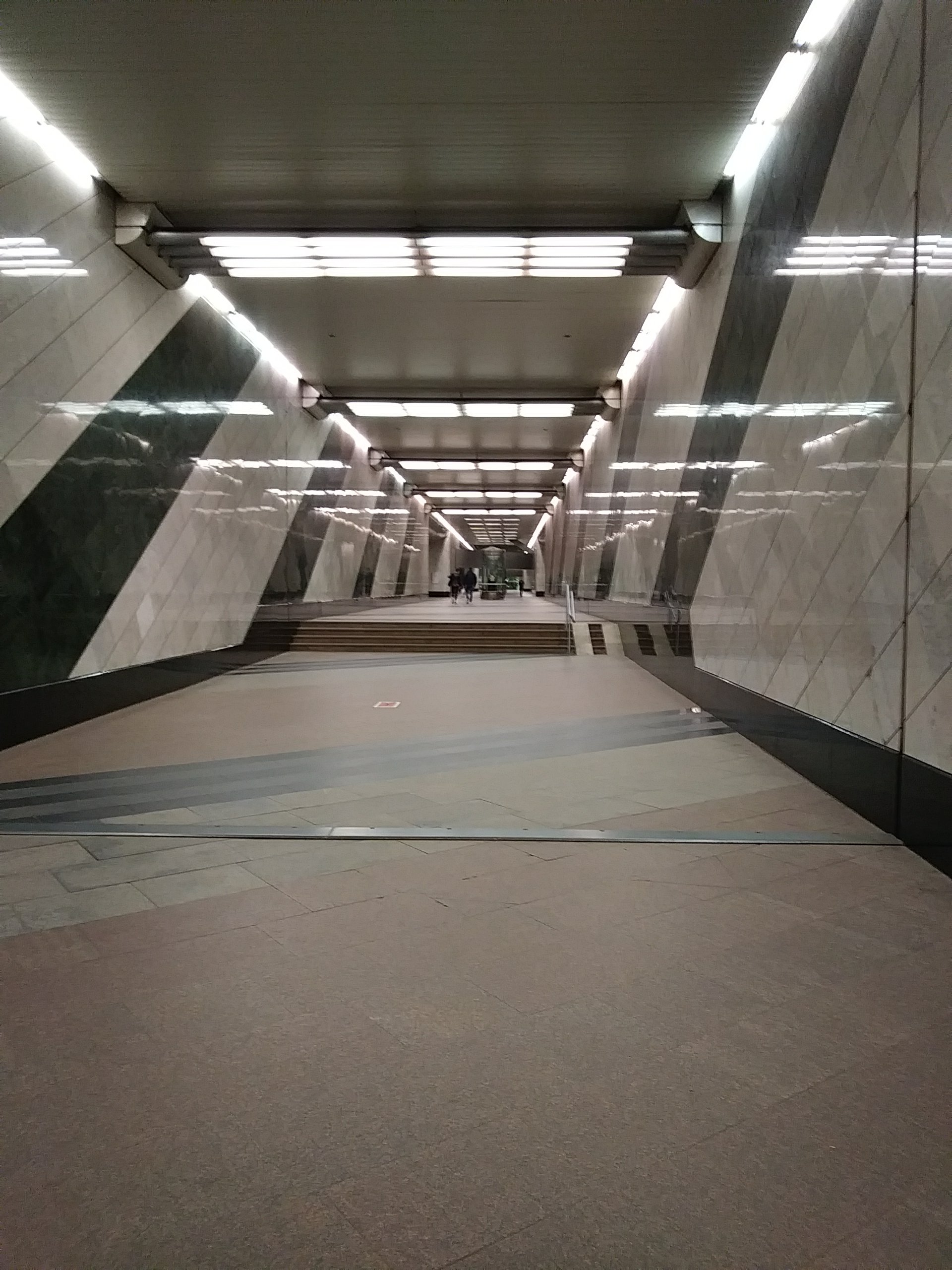вас тут не стояло – Your name is not on my list.
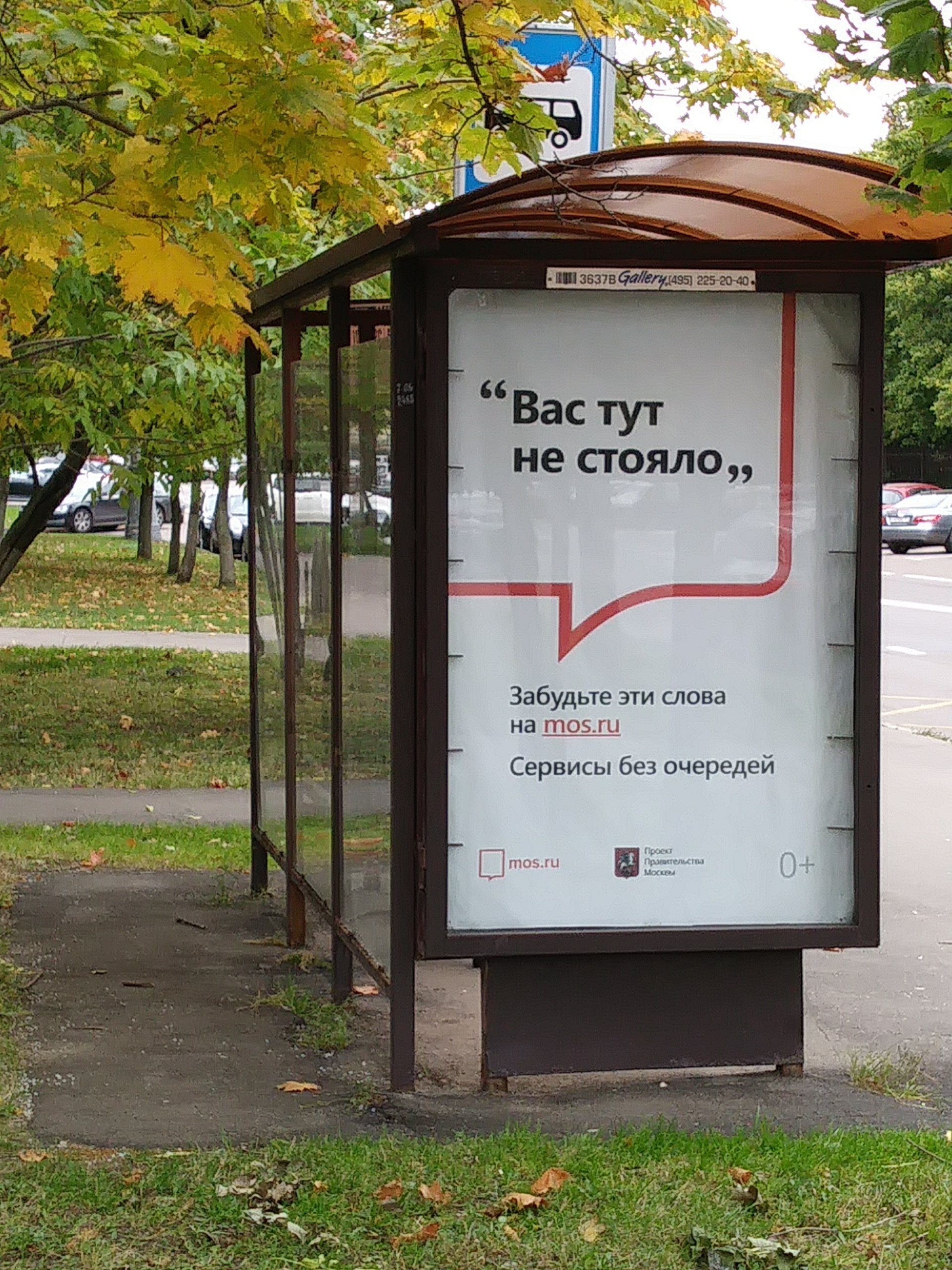 A poster from Moscow’s e-government campaign. It further reads Забудтье эти слова на mos.ru. Сервис без очередей = Forget these words on mos.ru (Moscow’s e-government and knowledge hub). Service without queues.
A poster from Moscow’s e-government campaign. It further reads Забудтье эти слова на mos.ru. Сервис без очередей = Forget these words on mos.ru (Moscow’s e-government and knowledge hub). Service without queues.
Monat: September 2017
Indian summer – Бабье лето
Until recently Moscow lacked any visible recycling schemes for residents‘ household waste; some voluntary recyclying points existed but not large-scale. This has now changed: Recycling bins have been installed at some location (I guess its a pilot) where they replaced traditional all-for-one bins (pictured below and far below, resp.)
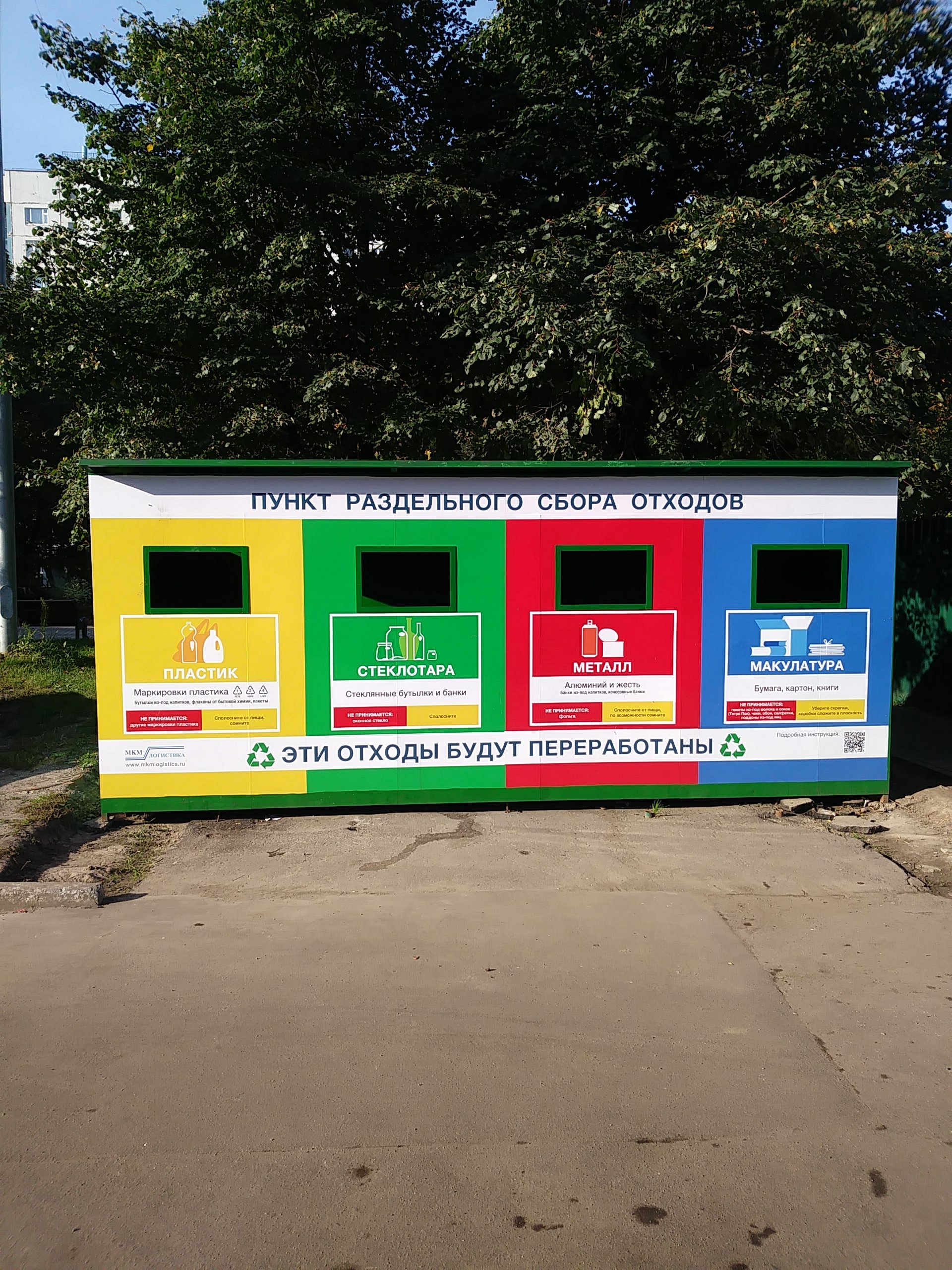
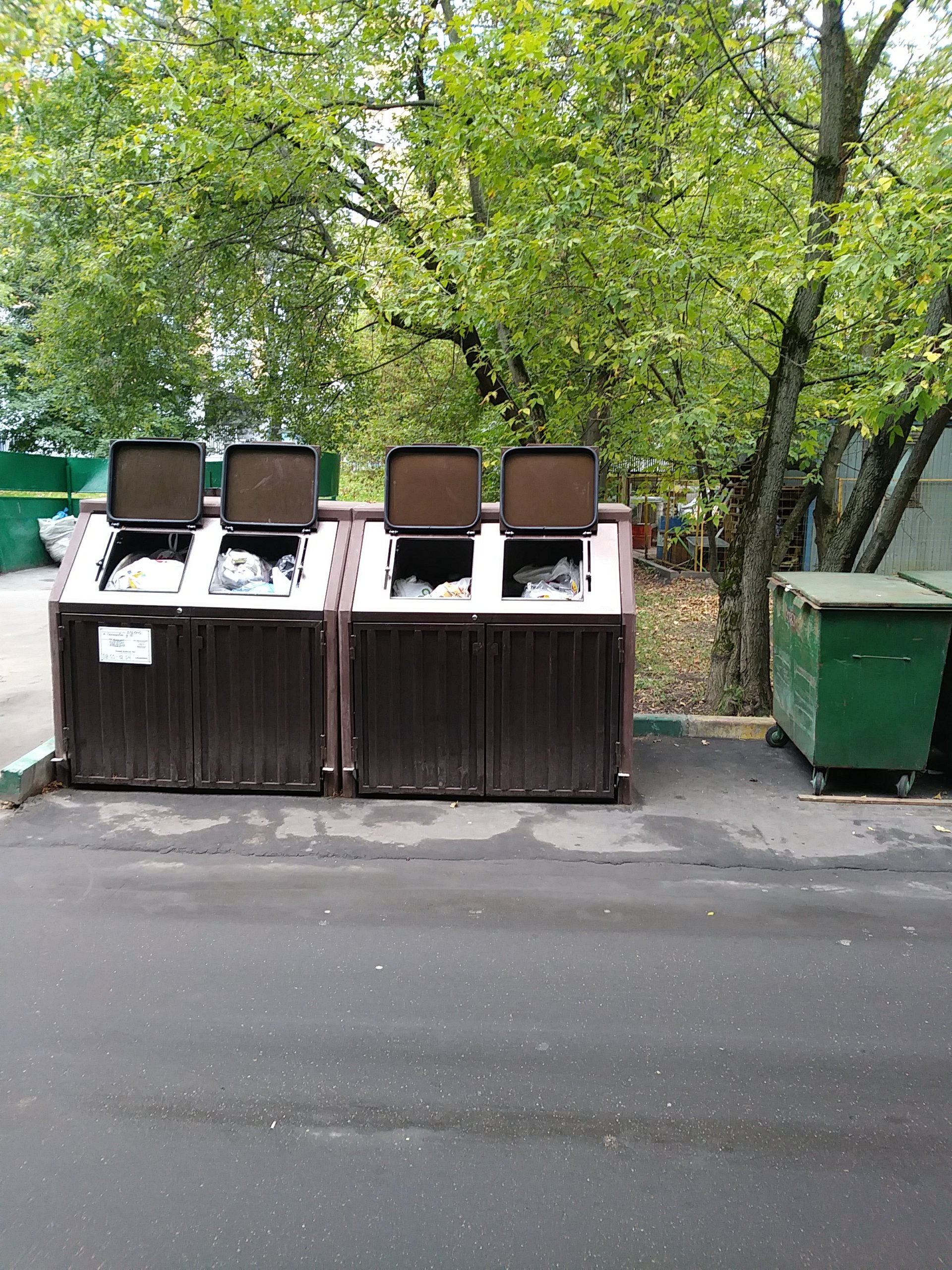
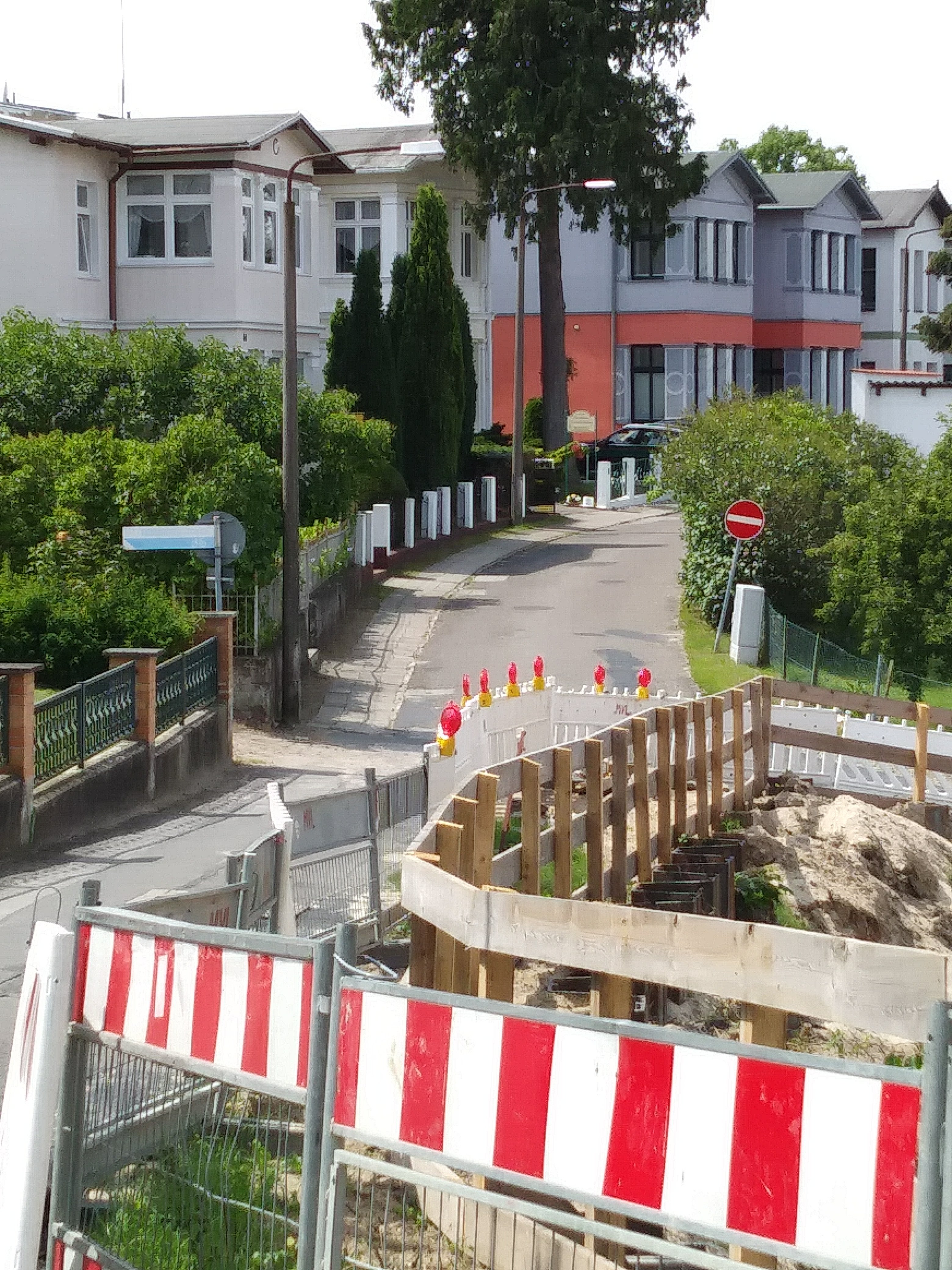
4. Vehicle-induced air pollution: The fourth challenge to contemporary policy makers in Germany justifies and deserves its own post: Eyerbody knows Dieselgate, but outside Germany little is known about the Rastatt incident. Both are essential linked together by demonstrating regulatory failure (the former) and complete ignorance of promoting sustainable public transportation (the latter) by federal government over the last 17 years. Everybody is aware of Dieselgate, that is, a software tool in 11m Volkswagen and seemingly Mercedes and Audi that cheats on CO2-emmission. In contrast to harsh meadures in the US Federal German government led the cheaters go in return for cheap talk such as the committment to install a yet another (funny, isn’t it) software update in all these dirty diesels still rolling on German roads.
The dirties road on the globe is not to be found somewhere in Bejing, but in Stuttgart, capital of the southern German state Baden Württemberg and home to Mercedes‘ headquarter. Given the extremly high paticulate pollution the local administrative court has ruled a prospective ban on diesel cars in the entire city center. In 89 additional cities and towns throughout Germany similar measures are expected. Issuing and regulation driving bans falls into the responsibility of local authorities. They will have to adress this issue boldy. And boldy to me mean a shift towards promoting public transportation.
This leads to the Rastatt incident. The major north-south railway route from Scandinavia down to Italy bypasses Rastatt (Rheintalbahn). During digging a tunnel for the bullet speed train line the railways on this route collapsed and deepened by half a meter. Shit happens. But given a lack of electrified, or any, alternative routes of similar size in this region of Germany, freight transportion simply stalled, passengers had to transfer on buses, bullet speed trains scheduled for Switzerland ended in Mannheim, south of Frankfurt. How does all this relates to policy makers and administrators, apart from not so well-prepared engineers? Well, Deutsche Bahn, which is responsible for running, maintaining and investing in a high quality competitive railway system, is a state-owned enterprise. Deutsche Bahn’s Chief Infrasructure Investment Officer for example is the former head of German chancellery. He totally ignored both the issue and the subsequent stalling of freight and passenger trains. So next time come up with a Train Summit rather than yet another worthless Diesel Summit.

Amid results of yesterdays German federal election and a likely fourth term of chancellor Angela Merkel the four most pressing policy issue will have to be solved by local government:
1. Public finances: Germany’s more than 12,000 municipalities divide into rich and poor ones. Prospering fancy cities, such Munich and Hamburg, but also a couple of more rural commumities benefit from companies such as Siemens or BMW, their local business tax payments, and indirectly, from payroll taxes of the employees working within these firms. On the other hand municipalities in North Rhine Westphalia, Rhineland Palatine, and Saarland are highly indebted. While consolidation agreements have been reached between several municipalities and state governments 70 to 80 percent of the budget in these localities goes to social spending inducted by federal legislation (housing for unemployed, labour market measures for people with disabilities) leaving little leeway for additional spending on early education
2. Kindergarten & Early education
Both falks into the responsibility of local government and administration. Federal law implemented in 2013 requires localities to offer access to a kindergarten within walking distance, or reasonable driving distance. Good. The next step is to raise quality of early education. Kindergarten, from my „silly“ perspective, means facilitating my kids’s development based on pedagogical concepts and aspiring educators, i.e. doing and learning to master things that Mummy and Daddy normalky can’t teach them at home.
3. Integration of migrants is the third policy challenge that local administrators and politicans are facing in Germany, regardless of whether we will see another Grand Coalition at federal level, or a get-together of Christian Democrats, Green party and Liberals. Again, while the big picture decisions on migration policy are being made at federal level, bringing people into work, offering accomodation, housing and language classes, and empowerings kids by ensuring sound early education more or less is up to local entities. As Gerd Landsberg, head of Deutscher Städte– und Gemeindetag, one of German Local government associations, yesterday put it an interview with Deutschlandfunk, a public broadcasting agency: Integration of migrants is a policy challenge that municipalities will have to deal with over the next years and probably beyond. Given the diversity of the local landscape will we see a varity of policy-solutions in the future.
City Lights

Below a nice illumination of flower beds in Moscow. It will get even more cosy in winter when they illuminate the nomerous small scale christmas trees.

This is a nice one in a public park:
KA is for Мойка.
 A Мойка is a place to get your car a shower.
A Мойка is a place to get your car a shower.
 City lights in early evening Moscow:
City lights in early evening Moscow:
And a last one:
This snapshot is symptomatic for Moscow in current days. Construction sites whereever you take a look. This is Lubyanka square where street lanes are being reconstructed. Pedestrians will get more space, motorvehicle based traffic is more hedged than previously. I appreciate this city planning approach. Makes the city a tad more safe, and a more convenient place to live. In times of dieselgate who experiences satisfaction from going by car anyways?
HSE Day 2017
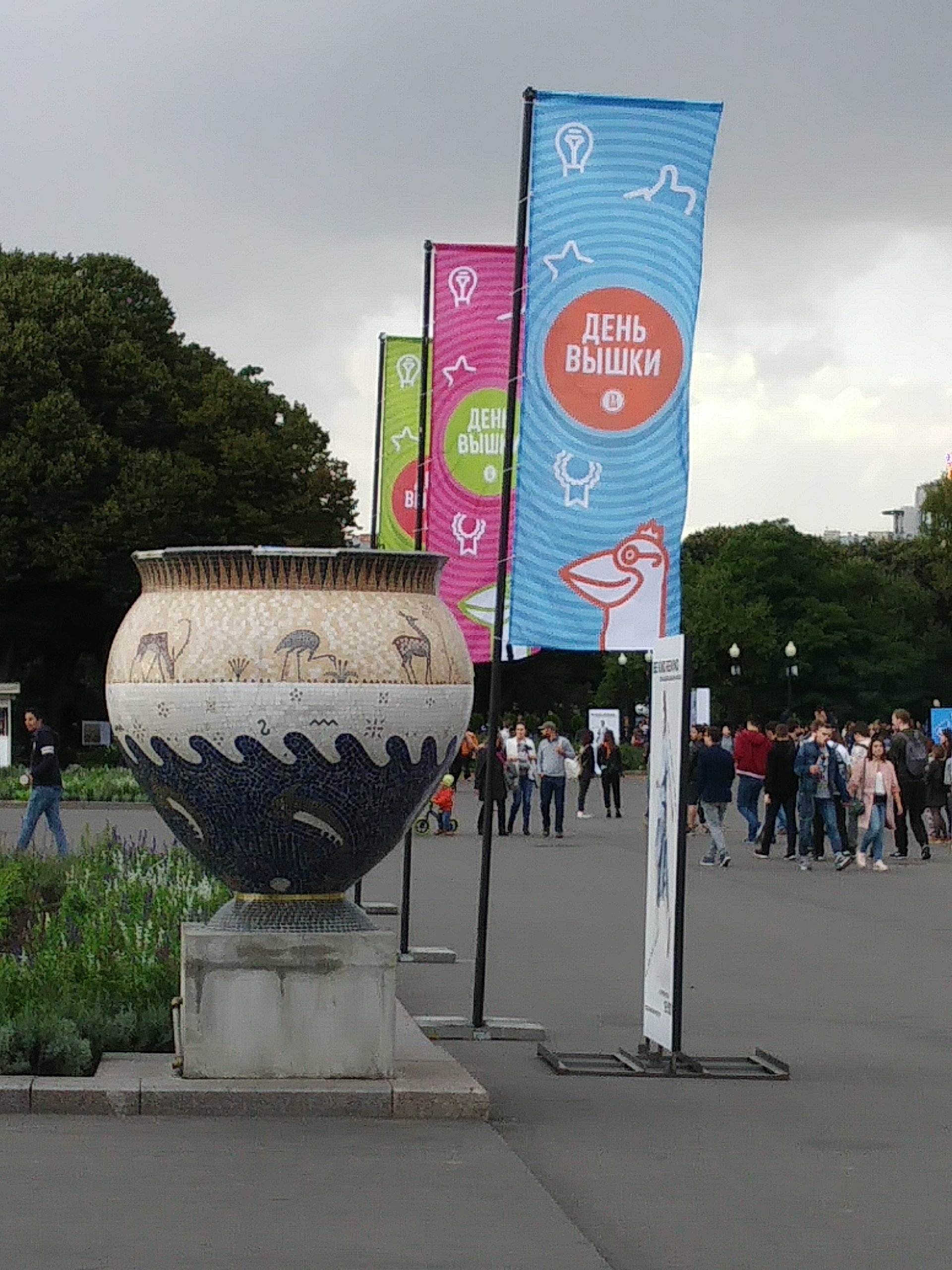
Happy Civil Servants
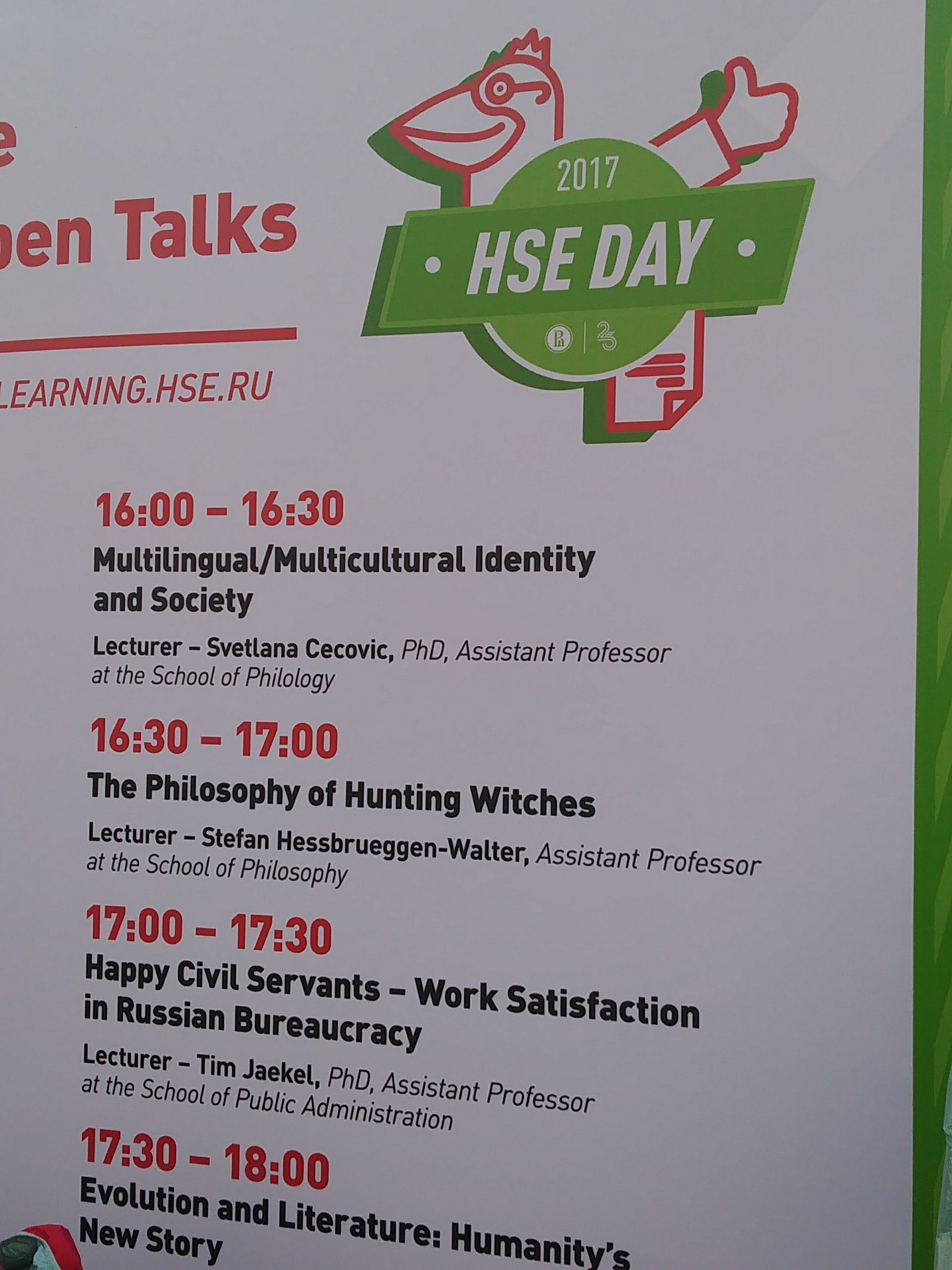
I am very proud that I was invited to give a Open Air lecture at this years HSE Day in Moscow’s famous Gorky Park. This year I talked about work satisfaction of Russian civil servants. And I presented new survey evidence that I collected last year.
I have been living and working in Moscow for two and a half years. Before I came here I remembered all the negative perceptions about Russian bureaucracy. And I experienced them also when arrived; with the customs office for example. But soon I saw and recognized that Moscow is a huge, dynamic city. I have been witnessing plenty of innovative things and practices, in large companies and small businesses and also in the public sector. Moscow is changing to the better, every single day. This is my honest view. I see new metro stations; I am using an entirely new rapid-transport system, MZK, and a see a lot of other small steps to make public service delivery more users friendly. Some weeks ago I posted a huge campaigning poster reading that Moscow has been successfully fighting a battle against its own bureaucracy for six years now to make service delivery more convenient for Muscovites. Wow!
On the other hand there is widespread negative perception of civil service. Russia really has an awful bureaucratic tradition, and a lot of its current culture derives from this legacy. People have low confidence in almost any public institution, even the presidential administration; which is kind of strange since trust in the president is at an all-time high. And this was a kind of gap to me, a mismatch. I studied administrative behavior in a couple of research projects here in Russia. And I can compare this evidence with my research results from Europe; where I conducted projects in Germany, Switzerland, England, and Sweden.
Research questions
In one of my latest research projects I was interested in the question: How satisfied are civil servants in Russia? Citizens’ surveys and public opinion polls tell us whether or not citizens are satisfied. Two weeks ago local elections took place throughout Russia; elections are another indicator for political support and satisfaction. But what do we know about work satisfaction of civil servants themselves? Are they satisfied with their work, pay levels and levels of responsibilities? My research project had the following research questions:
- What makes people happy at their workplace? And what factors drive people to feel unsatisfied at work?
- Are civil servants satisfied for different causes than non-for-profit employees? Is there any argument why civil servants should be more happy, or less?
- Are Russian civil servants more or less satisfied than civil servants elsewhere?
First I will briefly outline the theoretical framework of my analysis. I will hypothesize a number of relationships. I will present the dataset, and some key results. In a final step I will derive some conclusions from my findings.
Theoretical Framework
1. What makes people feeling happy at their workplace?
And what environments make people feel unsatisfied at work? (And why is this relevant?)
A high-quality working environment positively affects the performance and the wellbeing of employees. This in turn links to the performance of the overall organization. Happy employees will help an organization to reach its goals. Without happy employees any business firm, small startup, or government agency will not see innovation and quality in service delivery; but rather burnout, high turnover and low organizational commitment. Have you ever wondered by waiters in Moscow’s cafes at times seem to be rather unmotivated? Their work environment is not supportive; there is often rude tone from the top. So this is what they give in return. There is high turnover. In my pet Schokoladniza, every month there is a new team of waiters.
According to self-determination theory, SDT, each individual has three basic psychological needs: autonomy, relatedness and competence. Competence is a human’s need of being effective in dealing with its environment and master doing something; autonomy means to have some control over one’s own life. And relatedness means to have sound relationships with others. Human nature is adaptive, we are experience dependent. In a basic need supportive environment adaptive human nature “will move toward thriving, wellness, and integrity” (Ryan & Deci, 2017), we will see positive behavioral outcomes, such as prosocial behavior. But in a “context that are overly controlling, rejecting, critical, and negative, or that otherwise frustrate autonomy, relatedness and competence needs, individuals are more likely to become self-focused, defensive, unmotivated, aggressive and antisocial” (Ryan & Deci, 2017).
First, any working environment has to support basic psychological needs (competence, relatedness, autonomy) regardless the working sector (private, non-for-profit, public sector). Second, vocational theory and Person-Job Fit theory assume that an employee experiences satisfaction at work when her or his interests and abilities match the skills required and the opportunities offered by a particular vocation. Holland (1968) proposed that “individuals working in environments matching their interest areas are more satisfied”. A person with an artistic mindset will flourish in an artistic work environment. An extrovert will probably perform well in leadership positions.
Summary 1: A person will experience satisfaction at work in case his working environment supports basic psychological needs (competence, relatedness, autonomy), and, allows him to satisfy his or her personal professional interests, skills and abilities. In turn a working environment that frustrates basic human psychological needs, and does not match the personality, interests, and abilities will make a human being unhappy – in the long run. (We leave aside the discussion that a person may satisfy his or her upper level needs outside the workplace; family obligations, commuting, etc., strongly limit these opportunities anyways). There is a wide range of additional (upper level) psychological needs (achievement motivation, power motivation or altruism and prosocial motivation). People will be satisfied and happy in case their workplace supports these motivations. They will become self-focused, lack motivation, aggressive and antisocial, if not.
2. Are civil servants satisfied by different experiences than business employees are?
Turning to the public sector, what types of personalities are expected to flourish in government jobs? Public sector compensation schemes historically prioritize internal wage equity, modest pay rates, strong nonwage benefit packages, and relative job security. Moreover, the public sector has to address multiple ambiguous and hard-to-measure agency goals (multiplicity of goals). Public policies have to address the society as a whole; programs face difficulties in identifying customers, and segmenting or discriminating among users. Public managers possess limited managerial autonomy and experience high political interference. There is need for consensus in decision making, across agencies, among administrative and political stakeholders.
People who value helping others in relatively stable working relationships should experience satisfaction in public sector employment. In fact, public sector employees self-report higher levels of prosocial motivation, and altruism compared to private sector employees, in a wide range of countries. There is compelling evidence that people are socialized on the job. People adapt to the professional norms and culture of an organization. But this does not weak my argument: We assume that people who are willing “to engage in sacrificial behaviors for the good of others without reciprocal benefits for themselves” (Perry at al. 2015), a type of altruism, experience satisfaction from public sector employment”.
People who seek to support their country (patriotic service), or work for a common good (the public interest) experience satisfaction from public sector employment. They are more likely to report high level of job satisfaction. People who value modest, but stable and relatively secure income, including social benefits experience satisfaction from public sector employment. They are likely to report higher levels of job satisfaction. These assumptions are conditional on a working environment that satisfies the three basic psychological needs (competence, relatedness, autonomy): positive relationships among team members and colleagues, empowerment, encouraging feedback from supervisors, meaningful tasks.
3. Do we expect Russian civil servants to be more or less satisfied compared to civil servants in other countries?
Russia has a distinct culture of bureaucracy. The Soviet legacy: centralized planning economy, highly influential administrators, and extreme hierarchy from top to bottom. Some features have survived, and are still valid in contemporary Russian public administration. We would expect that a working environment with such a legacy attracts people with a strong desire to exert power and influence over others; this motivation is called power motivation (n power). These people experience satisfaction from exerting control; we should report higher levels of job satisfaction. Because public administration also has a historically strong impact on society, we also expect that people with a high level of achievement motivation self-select into the public sector. Having an impact on society will create satisfying experiences. They are more likely to report high level of work satisfaction.
Work satisfaction is a crucial issue in modern public management. But there is limited evidence on work satisfaction among current civil servants in Russia. My study is explorative in nature since it provides unique insight into contemporary civil service workforce.
How satisfied are civil servants in other countries?
In South Korea’s Federal, for example, government employees are quite satisfied according to data from Jesse Campbell and Tobin Im. Their sample mean value of overall work satisfaction is 3.68 on a 1-5 scale, where high values indicate high level of satisfaction.
US-researchers Pitts, Marvel und Fernandez in 2011 studied four aspects of work satisfaction (dissatisfaction with pay, dissatisfaction with benefits (retirement, health care), and dissatisfaction with opportunities for career advancement, growth and promotion). In US federal government work satisfaction is even higher among employees compared to South Korea. The mean value is 3.705 on a 1-5 scale. Satisfaction varies: Employees are more satisfied with their pay levels than with health care related benefits and pensions. (In the US costs for health care are very high, this may explain the rather high level of dissatisfaction); they are more satisfied with advancement opportunities than with benefits.
| Mean Value | |
| Overall Job satisfaction | 3.705 |
| Pay | 3.606 |
| Advancement opportunities | 3.016 |
| Benefits (retirement, health care) | 0 (min -2.905, max=1.441) |
Pitts, Marvel, Fernandez, 2011 PAR.
Despite common stereotypes and low levels of trust in administration employees are still quite satisfied. In advanced administrations overall job satisfaction is still quite high. Satisfaction varies between aspects of working environment.
Do Russian civil servants differ from their counterparts elsewhere in terms of happiness?
15 years ago in 2002/3 Eugene Huskey from Stetson University and Alexander Obolonsky from the Higher School of Economics surveyed civil servants from across different layers of government. Civil servants were rather satisfied with citizens’ interaction, colleagues and the prestige of their jobs. Quite satisfied means that for each dimension at least 50 per cent said there are satisfied. They were rather dissatisfied with job security, personnel policies, and perks (benefits, bonuses). And they were the least satisfied with pay.
My Data
I did not survey employees in central government / administration, and in Moscow, but in municipal (local) administration in a southern region of Moscow. The survey was conducted in autumn 2016. About 500 employees took part in the survey. The average respondent is female, 37 years old, and has seven to 15 years of working experience.
Job satisfaction
I asked respondents to rate their level of dissatisfaction with three aspects of their work: degree of responsibility, amount of workload, and pay. Local civil servants are most satisfied with the level of responsibility assigned to them (about 2.5 on a 1-5 scale). They are less satisfied with their workload (about 2 on a 1-5 scale). The level of pay is cause for serious dissatisfaction (about 1 on a 1-5 scale). This is an impressive picture: my first finding is that local civil servants in Russia are far more dissatisfied than federal civil servants in the US and South Korea. The level of pay, in particular, is a cause of serious dissatisfaction. Local civil servants are rather unsatisfied with their workload, too. The level of responsibility is the aspect of their work with the highest level of satisfaction. The results coincide with the findings from Huskey und Obolosnky from 2003. 15 years ago a majority of civil servants was unsatisfied with salary.
Discussion
Stable income and job security are the strongest attraction of government jobs. A relatively stable and secure income draws people into public sector employment. But this expectation is the one which is satisfied least. Low pay levels create a serious dissatisfaction among civil servants.
Local civil servants express significant dissatisfaction, but stay in their job. This suggests that civil servants derive satisfaction from non-monetary incentives (mission commitment, perceived social impact), as proposed by PSM theory.
I did not ask respondents to indicate their intention to leave their job (turnover intention) or to switch the working sector. But data from Huskey and Obolonsky support this interpretation: While most civil servants were unsatisfied with their salary, a majority expressed high level of satisfaction with citizens’ interaction. Interaction with citizens and customers demonstrates the social impact of one’s own work.
Civil servants draw satisfaction from non-monetary incentives (intrinsic job motivators). Experiments in public administration demonstrated that beneficiary contact has a positive impact on performance.
Further items from my survey support this statement. About 80 per cent of respondents perceive public administration employment as a mean to help other people. 65 per cent perceived their job as patriotic service to their motherland. Helping others and patriotic motives are aspects of prosocial motivation.
Summary and Conclusions
I began with describing a seemingly mismatch: A lot of new practices, but negative perceptions enriched by personal anecdotal experiences. The survey was motivated by the question “How happy are civil servants themselves?”
To answer this question I surveyed about 500 local civil servants in a region in the south of Russia. Data show that Russian civil servants are less satisfied than civil servants in the US, or South Korea. Pay in particular is a source of serious dissatisfaction in contemporary local civil service; as it already was 15 years ago. Civil servants are rather satisfied with the level of responsibility assigned to them.
The data further show: civil servants in Russia express rather high level of prosocial motivation. This coincides with international data from Bullock, Strich, and Rainey from 2016. The findings suggest: As in other countries local civil servants in Russia seem to draw job satisfaction from non-monetary incentives (intrinsic factors).
Why don’t people leave their workplace for a better one? An alternative interpretation: In a way there is a lock-in effect. In some regions of Russia, public service is a primary employer. The likelihood of finding a better job is relatively low. People stay in their job, express levels of dissatisfaction, but use focus on intrinsic life goals.
One implication for practitioners is to engage civil servants in beneficiary contact. Contact with customers will help to experience social impact, which will raise levels of satisfaction. Moscow’s one stop agency campaign is the right direction of travel.
I received a lot of interesting and inspiring questions from the audience, such as:
- What draws students to work in the public service upon graduation? This is an interesting question; and I studied it together with George Borshchevskiy. Results appeared in the Russian Journal Sociology of Education and as HSE Working Paper.
- How does the motivation of Russian civil servants compare to Chinas public administrators? Is the Russian system of selection similar to the Chinese one?
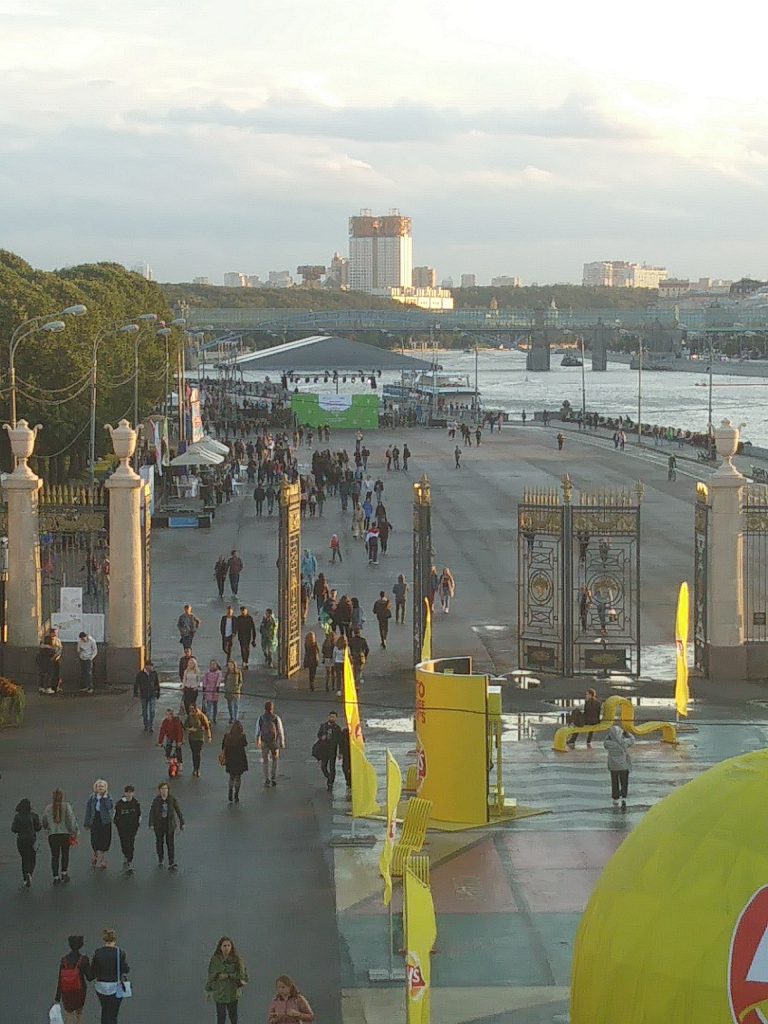
This is the second post in a series on swimming pools in Moscow. The Aqua complex on Lyzhniki’s huge olympic sport area Moskva offers a high-quality outdoor pool. The pool has eight 50 meters lanes. There are no starting blocks on either side of the pool. The admission fee for a 90-minutes session is 800 roubles. In contrast to most public pools admission does not require a medical certificate!
The pool is locate just next to Воробьевы горы (Sparrow Hills) metro station on the famous red line (pictured below). An alternative is to exit Moscow’s new rapid transports system’s (МЦК, Moscow Central Circle) Lyzhniki station.


